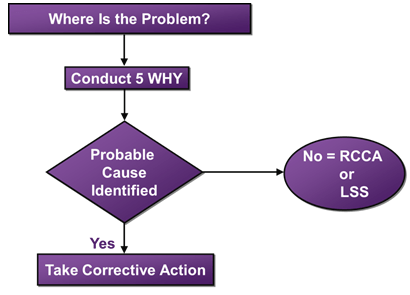Kaizen Rapid Improvement Teams
Inevitably most, if not all, Kaizen or Rapid Improvement Teams encounter problems along the way as they transform identified current state conditions into new and improved future state conditions. Typically this occurs once the current state value stream map is completed and analysis of the information begins.
The problems can be an array of issues such as:
- poor frequency and method of transportation for materials and components
- incorrect delivery intervals to reduce inventory
- propinquity of the supply base to minimize shipping times
- too much day to day (week to week, month to month, etc.) variation in demand
- long cycle times
- long changeover times
- workload balancing
- large work in process inventories
- low uptime percentages
and so forth…
Once these problems are identified “Kaizen Bursts” are placed on the value stream map to assist the team with review and prioritization activities that will enhance future state and accelerate efficiency improvements and waste reduction.
These identified problems are typically due to “special causes.” They are not chronic, common cause issues which require higher order tools to correct; but rather are the result of sporadic or special cause variation.
The challenge many teams face is to determine how to proactively and systematically address the identified special cause problems.
One effective tool to use is called 5-Why Analysis. This tool is a qualitative tool, not a quantitative tool, that helps simplify causes of sporadic problems. 5-Why Analysis helps to identify what, how, and why something happened. Typically the causes are underlying, reasonably identifiable, and can be controlled by people. The analysis involves data collection, charting to identify causes, and making recommendations to prevent reoccurrence.
A pictorial view of 5-Why Analysis is as follows:

Simply stated, to use 5-Why Analysis the team should define where the problem is occurring; create a description of failure – be as specific as possible; complete a systematic diagnostic journey using the 5-Why tool to identify true root causes (not systems) for the identified problem; take corrective action to ensure the problem been eliminated; and ensure proper metrics and procedural changes are institutionalized in the Control phase of the value stream management journey to ensure improvements to future state are sustained.
Specific steps to complete the 5 WHY Analysis are:
- Define the problem or failure.
- Ask – why did it happen? There are probably multiple possibilities.
- Go to the location of the problem (the Gemba). Determine which of the possibilities actually caused the problem.
- Ask – why did the item that caused the problem happen? There are probably multiple causes.
- Go again to the location. Which one caused the problem?
- Now that you get the point repeat this process 5 times.
Remember 5-Why Analysis is best used for sporadic, special cause problems related to waste and inefficiencies in your value stream. Used properly, it is a valuable tool for addressing these problems, identifying root causes, and taking corrective action to optimize your future state conditions.
For more information on kaizen and how Juran can use it to improve your business productivity, please get in touch with the team.
| Check out Juran’s LSS Training Courses |
| Lean Six Sigma Yellow Belt |
| Lean Six Sigma Green Belt |
| Lean Six Sigma Black Belt |
| Upgrade to Black Belt |
| Lean Six Sigma Master Black Belt |
| Lean Expert Program |






